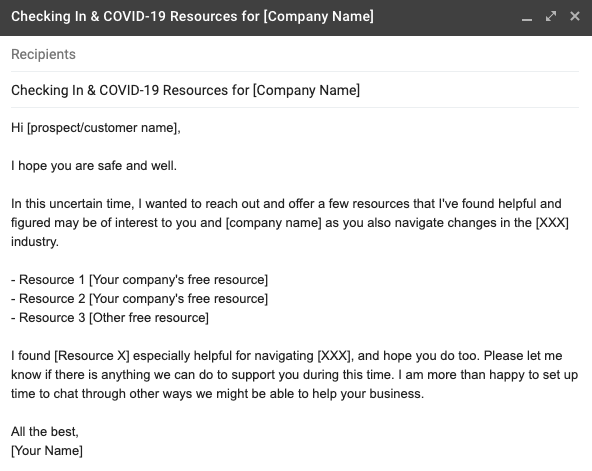COVID-19’s drastic economic impact has forced sales and customer teams to adapt in a multitude of ways. Economic uncertainty makes it even more challenging for salespeople to hit their quotas, and requires customer-facing teams to promptly and effectively respond to the needs of their customer base. As the situation continues to evolve, it’s increasingly important that sales and customer teams adjust their strategies and approach conversations and interactions with empathy.
While the idea of practicing empathy in sales and customer interactions is not new, it is more important than ever to approach each and every interaction in a respectful and thoughtful way. Employing the concept of empathy by taking a step back and putting yourself in someone else’s shoes is the key to succeeding in this climate, also ensuring you and your company come across as sensitive and understanding. Not only is this extremely important from a reputational standpoint, it’s also important from a moral one.
Here are five simple ways to practice empathy in sales and customer interactions.
1. Refine Your Research
Sales and customer teams are generally advised to do preliminary research on their contacts before they hop on the phone or send an email. It’s common knowledge that citing simple information like details about your prospect’s industry and company proves helpful in closing deals, as it allows teams to approach conversations from an informed perspective.
Practicing empathy in the current climate, however, requires more pointed research on each account and company you’re planning on reaching out to. Indicators like company buying power (how much money they have to spend) which can be indicated by recent funding, and information on how their specific industry is faring in this economic climate are important to assess.
A good place to start is by leveraging tools that allow you to access recent funding rounds and information about private and public companies. Before reaching out to a prospect or customer, be sure you have an understanding of how COVID-19 may be impacting their business.
2. Invest In Personalization
For salespeople, knowing about the potential impact of COVID-19 on a prospect’s business is only the first step. Once you have this information, you need to dig a little deeper and requalify your leads. With a historic number of layoffs and companies being forced to make tough decisions, a lead you’ve contacted before might no longer be with the company. Do a quick search for the specific person you’re planning on reaching out to and see if you can ensure they’re still at the company. This will help keep you from email bounce backs and coming across as insensitive to the person you’re trying to contact. It’s a small world, afterall.
Another thing to consider is that the prospects you were in contact with before COVID-19 hit might no longer be the decision-makers at the company. In a recent article, Crunchbase Head of BD and Sales mentioned: “It’s important to understand that even if an account has a budget to spend, your contacts at that company may not have the same decision-making power as when you first connected. With tighter budgets, finance teams may now be the primary decision-makers, identifying which investments are absolutely necessary and what services can be cut.” Ideally prospects will let you know if that’s the case, but if you receive a no from a prospect now, it could be because they are no longer making these decisions.
For customer-facing teams, this could take the form of reaching out to your customers and contacts individually with a simple note wishing them well. If you know their company is going through a hard time, a thoughtful note that is not related to trying to sell your product can go a long way.
3. Ensure Each Contact Is Thought Through And Respectful
While you may be feeling immense pressure to hit quotas and perform, the best way to channel that pressure is to use it to refine your sales strategy and focus on better understanding the situations your prospects or customers may be in. The people you’re contacting may be feeling similar pressure or stress and your call, email, or message could be received differently depending on messaging and timing.
Take this simple email for example:


By placing an emphasis on empathy in your sales strategy, you’re opening the door for more meaningful and substantive conversations. While a prospect might not have the capacity to buy now, the conversations you have now will most certainly have an impact on your success down the road.
Some states have implemented measures that make cold calling in states of emergency illegal, so it’s important to keep a pulse on the current status of outreach limitations and abide by laws intended to reduce stress.
4. Offer Resources
As demonstrated in the example email above, if your company is offering free resources, discounts, or any kind of support, use this as a time to share those resources with prospects and customers. Even sharing resources you’ve come across that were created by other companies, or that have been shared with you, that could be helpful for your contact is a great way to build rapport.
For example, our team at Crunchbase has compiled a blog post with resources from our company as well as resources from other companies, and our sales teams are sharing this resource, along with content and news that may be helpful to prospects, as part of their new sales strategy.
5. Put Yourself In Their Shoes
The only way to truly connect at such a challenging time for so many is to practice empathy. Imagine if your company is going through massive budget cuts and had to lay off employees, and you received a generic cold call from someone trying to sell you something. Imagine if your family and/or loved ones have been impacted by COVID-19 and you’re balancing the stress of caring for them and working.
There are so many unforeseen situations that people now have no choice but to find ways to navigate. Be sure you’re the one helping them navigate, rather than the one clogging their inbox with desperate emails and tone-deaf messages.





